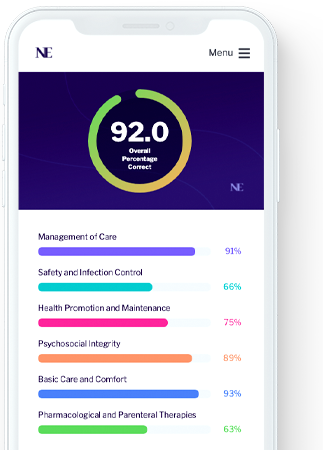LPN to RN Programs
Licensed practical nurses (LPNs), also known as licensed vocational nurses (LVNs) in California and Texas, are important members of the healthcare community, providing direct patient care in a variety of settings.
There are many paths to becoming a registered nurse (RN). Some people choose to become an LPN first, then go back to school at a later time to obtain either an Associate Degree in Nursing (ADN) or a Bachelor of Science in Nursing (BSN). This guide will discuss the different ways a licensed practical nurse can become a registered nurse.
What is a Licensed Practical Nurse (LPN)?
Licensed practical nurses (LPNs) are nurses who provide direct nursing care to patients. LPNs most often work in clinics, schools, home health, and long-term care facilities. Some hospitals still employ LPNs, particularly in rural areas, but this has become a less common practice as more hospitals shift to an RN-only staffing model.
Licensed practical nursing does not require a nursing degree. Instead, LPNs must complete a licensed practical nursing program and obtain a diploma. LPN programs are usually offered at community and technical colleges and take approximately one year of full-time study to complete.
LPNs work under the supervision of RNs, mid-level providers, and physicians. The LPN’s scope of practice is more narrow than an RN’s and it can vary by state of practice. Generally, LPNs are legally only allowed to care for patients who are medically stable and do not require complex nursing interventions. There are also certain nursing tasks that are outside the LPN scope of practice that only RNs are allowed to perform, which are outlined below.
According to the U.S. Bureau of Labor Statistics, the median salary for licensed practical nurses is $54,620.
What is the Difference Between a Licensed Practical Nurse and a Registered Nurse?
Although LPNs and RNs are similar in many ways, there are a few key differences between them. The two biggest differences are scope of practice and education requirements.
Licensed practical nurses usually provide basic nursing care to stable patients within clinics, schools, and long-term care facilities.
Examples of tasks performed by LPNs include:
- Administration of most medications
- Obtaining vital signs and monitoring patients for changes in condition
- Performing phlebotomy
- Obtaining specimens for laboratory testing
- Providing basic wound care
- Assisting patients with activities of daily living (bathing, feeding, toileting, mobility)
Registered nurses, on the other hand, are responsible for more complex aspects of patient care. RNs are trained to manage patients who may be unstable and require advanced nursing interventions. RNs are typically employed in a wider range of healthcare settings compared to LPNs, including hospitals, outpatient centers, home health, long-term care facilities, and more.
Examples of tasks performed by RNs include:
- Conducting patient assessments
- Administering medications
- Obtaining vital signs and monitoring patients for changes in condition
- Inserting and maintaining intravenous lines, nasogastric tubes, and urinary catheters
- Performing phlebotomy
- Obtaining specimens for laboratory testing
- Providing basic and advanced wound care
- Providing education to patients and their families
In most states, there are a few tasks reserved exclusively for RNs that LPNs are not legally allowed to perform within their scope of practice. These usually include:
- Administration of blood or blood products
- Administration of IV push medications
- Administration of chemotherapy agents
- Performing initial assessments on patients
- Providing education to patients and/or family members
Another key difference between LPNs and RNs is the amount of education required.
LPNs require completion of a licensed practical nursing program and successfully passing the National Council Licensure Examination for Practical Nurses (NCLEX-PN). RNs must obtain at least an Associate Degree in Nursing and pass the National Council Licensure Examination for Registered Nurses (NCLEX-RN).
How to Transition From LPN to RN
It has become rather easy to transition from LPN to RN since LPN to RN bridge programs are offered at many colleges and universities across the country. Most LPN to RN programs are LPN to ADN, but some colleges offer LPN to BSN as well. LPN to RN programs are specially designed to build upon the clinical knowledge that LPNs already have and to help them gain the advanced skill set and critical thinking necessary to become competent RNs.
Once you have decided to transition from an LPN to an RN, there are several factors to consider. Career goals, financial considerations, and personal responsibilities all play a role in determining which path to becoming an RN is the best for you.
Option #1: LPN to ADN
This is the quickest path for a licensed practical nurse to become a registered nurse. LPN to ADN programs are usually offered at community or technical colleges and take between 1.5-2 years to complete. Credit is usually received for prior coursework completed during the student’s LPN program as long as the program is accredited.
After graduating from an ADN program, you are then eligible to take the NCLEX-RN examination. After passing the NCLEX-RN, you can apply for RN licensure within the state you wish to practice.
It is important to consider that although obtaining an ADN is the fastest way to become an RN, it does not provide as many job or advancement opportunities as a BSN does. If your long-term career goals involve a leadership/management position or pursuing a graduate degree, you may prefer to obtain your BSN instead.
Another point to consider: Many employers offer tuition assistance to ADN-prepared nurses to return to school and obtain their BSN. Tuition assistance programs can be a great help financially, but they often come with important stipulations.
For example, some employers require the employee to work for them for a certain number of years after finishing their degree. If the employee resigns or is terminated prior to completing that commitment, the employee is liable to pay a portion of the tuition back to the employer.
Option #2: LPN to BSN
This is the longer path for a licensed practical nurse to become a registered nurse, but it does have some benefits. Many employers prefer to hire RNs who have a BSN, so BSN-prepared nurses have a distinct advantage during the hiring process. BSN-prepared nurses are also considered for leadership roles and advancement opportunities more often than ADN-prepared nurses. In general, having a BSN allows for more career opportunities compared to an ADN or LPN.
Most LPN to BSN programs take around 3 years to complete. Credit is often received for prior coursework completed during the student’s LPN program. However, if the student attended an unaccredited LPN program, their credits may not transfer.
After graduating from a BSN program, you are eligible to take the NCLEX-RN examination. After passing the NCLEX-RN, you will be able to apply for your RN license for the state you wish to practice in.
If you are considering graduate school in the future, obtaining a BSN is your best option. You cannot pursue a Master of Science in Nursing (MSN) or higher without first holding a BSN.




